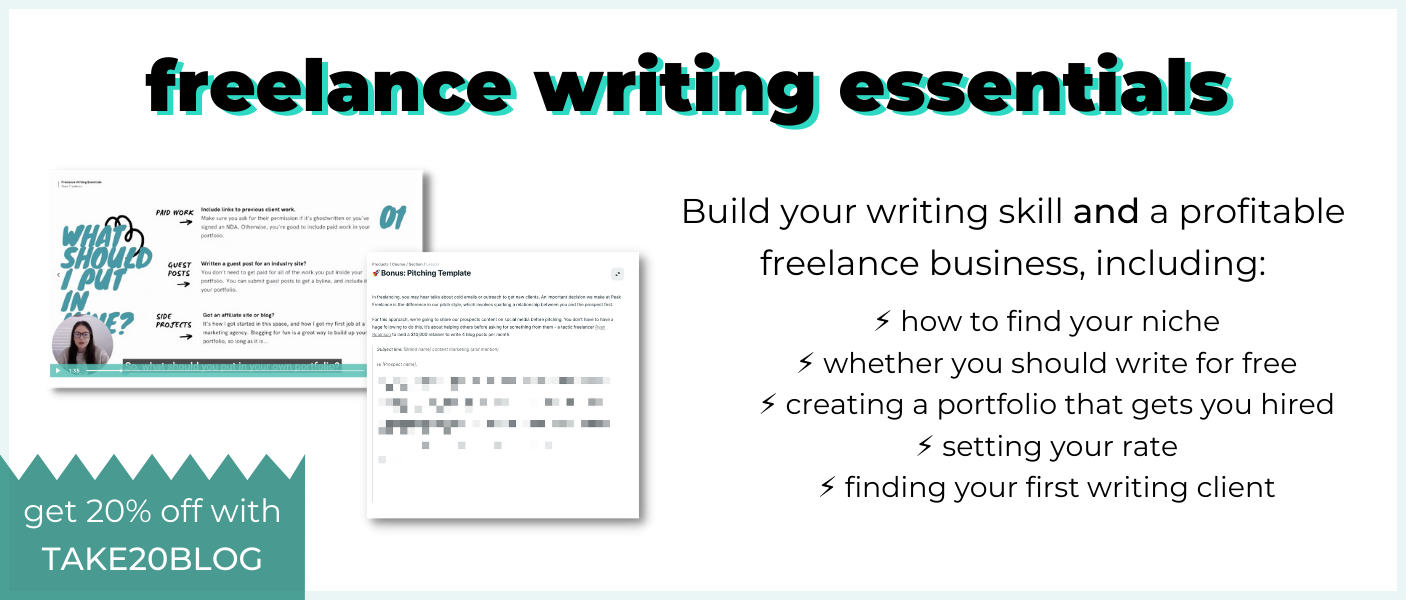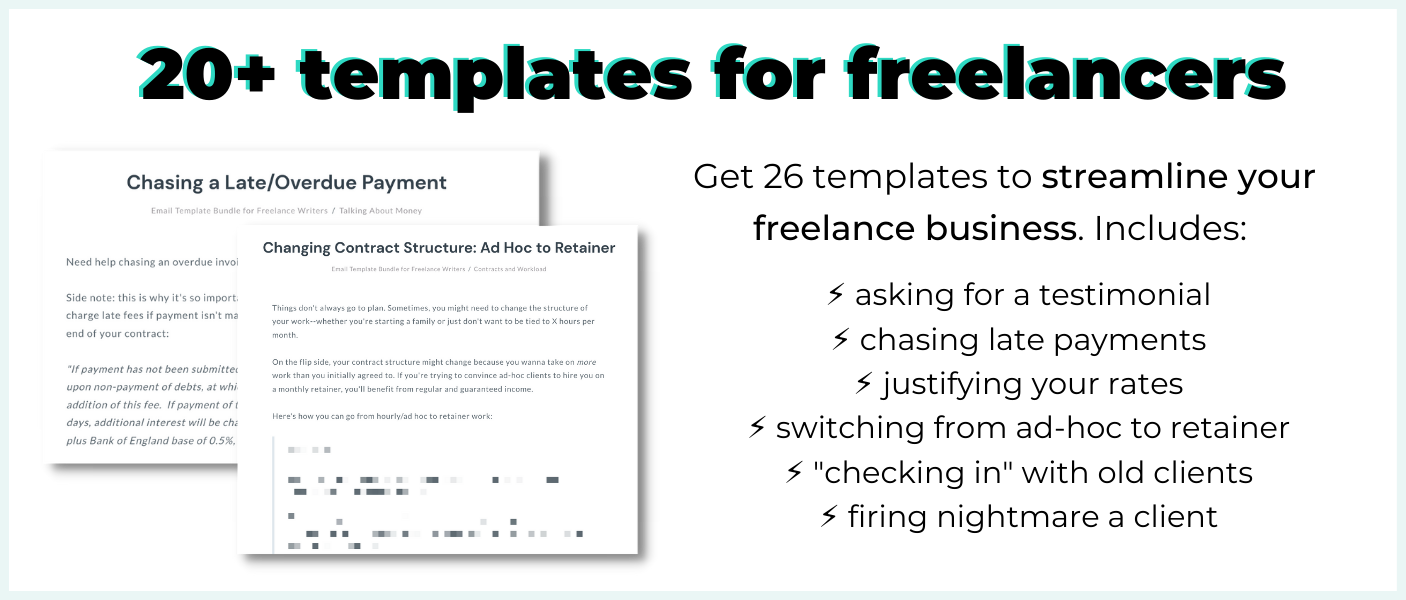Has a client asked to see a freelance writing sample?
You don’t have to scratch your head and put together an off-the-cuff writing sample to prove that you can write. A good writing sample doesn’t just prove that you’re a good writer. It convinces them to hire you, too.
In this guide, we’ll show you how to create a writing sample as a complete newbie.
What is a freelance writing sample?
A freelance writing sample is a document that proves to a client that you can write. A writing sample can take many forms, and usually depends on the type of writing services you specialize in–be that blog posts, emails, whitepapers, short stories, or landing pages.
A writing sample is key if you’re new to freelance writing. Potential clients want to see that you’re worth hiring (and spending their marketing dollars on) before they ask you to start writing for them.

Why do I need writing samples?
Still unsure on why you need a writing sample, anyway?
The most important reason is that potential clients want you to prove that you know how to write. Clients will only invest in writers they know can do their job properly. They’ll get that confidence by reading your writing samples beforehand.
(If you’re finding writing gigs on freelance job boards, most prospective clients will ask to see a sample before they hire you for this reason.)
Not only that, but writing samples give people a good indication of your writing style. They’ll see how you format your content, whether you use statistics, and if your tone of voice fits with their company’s.
7 types of writing samples
Writing samples form part of your freelance writing portfolio.
It’s a library of your best work that contains links and snippets of of content you’ve written for real companies or websites–be that:
- Guest posts
- Emails
- Landing pages
- Brochures
- Creative writing
- Ad copy
- Short stories
The good news is: even if you’re not a freelance writer with an existing library of content to highlight in your portfolio, you can create writing samples in the form of content for fictional clients.
You’ll just write content for a client you’ve made up (similar to those you want to target.)
Let’s put that into practice: Say you’re a new freelance writer who wants to write blog posts for software companies. You can create a fictional client who sells sales software, and create a sample blog post that would attract their target customers. Something like “How to Manage Your Sales Pipeline” would do the trick.
The key to a good writing sample is to create one similar to your target client. Think about the content they’d want on their website–and create it, in the form of a writing sample.
How long should a writing sample be?
The length of your writing sample depends on what type of content you’re writing.
Remember: a freelance writing sample shows a potential client that you’re a good hire. It should match the type of content you’re offering, too–something that has a huge knock-on effect on the length of your writing sample.
Say you’re a copywriter specializing in emails, for example. Most of your writing samples will fall between the 250-500 word mark. A copywriter specializing in landing pages, however, might have writing samples averaging around 1,000 words.
The bottom line is: don’t get too caught up in the word count of your freelance writing sample.
Just think about the type of content your ideal client would want to read, and match it with your sample. It’ll prove to them that you know how to write the content they’re looking for.
How to create your first sample for freelance writing clients
Are you ready to create your first writing sample?
Not only will you convince potential clients that you’re a great writer, but it’s a superb way to get your freelance writing career off the ground and find your first few clients.
Blogging is a freelance writing niche set to skyrocket this year. So, let’s take a look at how you can write a blog post sample that lands clients.
(You can use a similar process for other types of content, too.)
- Prepare a content brief
- Write a headline
- Hook them with an introduction
- Break the content into subheadings
- Add statistics and data
- Write a conclusion
- Make the Google Doc shareable

1. Prepare a content brief
When preparing a writing sample, it’s smart to create a brief.
A writing brief details what the end blog post should look like. A client usually gives them to freelance writers before the start of each project. It includes things like:
- Who the content is targeting
- The goal of the content
- What keyword it should try to rank for
- How it plays into their wider content marketing strategy
- What product features to mention
- The client/website’s style guide
(If you’re basing a writing sample off a previous client project, make sure you get their permission to include it in your portfolio.)
But even if you’re creating a writing sample for a fictional client, you could always make your own content brief and base the sample off it.
It’s an easy way to prove that you know how to follow instructions, and write a blog post based on a keyword, targeting a specific audience, and discussing certain product features.

2. Write a strong headline
A headline is what convinces readers to click through and read your blog post. Nobody will see it if the headline isn’t enticing enough to make them want to click it.
It’s why most clients look for freelance writers who know how to write strong headlines.
Show you can do this by writing a strong headline for your writing sample.
It should be directly related to the blog post itself (without any clickbait), and have a smart play on words that stand out in Google’s search results.
For example: “How to Write a Blog Post” can turn into “10+ Actionable Steps to Write Blog Posts Your Readers Will Love.” Much better, right?
Don’t just stop at one headline, though. Brainstorm 5-10 headlines and list them at the top of your writing sample. It’ll show your client that you’re creative enough to think of headlines, and aren’t afraid to play around with them to find the most click-worthy headline.
One you have your shortlist, run your headline options through a writing tool like CoSchedule’s Headline Analyzer. It’ll give pointers on how to make a good headline even stronger.
Run with the highest-scoring headline for your writing sample:
(Depending on how good you are at writing headlines, you might want to do this step last once you know exactly what the blog post covers.)
3. Hook them with an introduction
Once you’ve got someone to read your writing sample, a strong introduction will convince them to stick around and read the entire thing.
I like to use this introduction formula:
- Aggravate the problem a reader is experiencing
- Elaborate on things they’ve already tried (and have been unsuccessful with)
- Promise a solution if they keep reading
Here’s what that looks like in practice:
Use a similar formula to write the introduction to your writing sample.
Prospective clients will be hooked from the first few sentences–and stick around long enough to convince them to hire you.
4. Break the content into subheadings
Did you know that most people don’t read your content word-for-word?
More people than ever skim-read content they find online. They might read the introduction, the first section…and then skim read the rest of the content until they see something that grabs their attention.
Subheadings make it easy for readers (and the prospective clients reading your writing sample) to scan. They can see, at a glance, what’s covered in your writing sample.
Plus, headings help optimize your content for SEO. Search engines use headings to understand what a page is about, without reading the entire thing. It gives them a good indication of whether your content is comprehensive enough to rank for the keywords you’re targeting.
Most word processing software has heading tags built into their tool. Use them in your writing samples to prove to a potential client that you know how to use them.
5. Add statistics and data
It’s not just writing skills that potential clients want to see in your sample.
They also want to see that you’re a good researcher that can dig into reports to pull relevant statistics, data points, and survey results.
So, find some relevant statistics to add into your writing sample. For example, if you’re writing about online marketing, find a statistic that shows how online marketing is gonna explode in 2021.
If your writing sample talks about the best publishing platforms for your client to consider, find out how many websites are hosted on each.
Adding these extra statistics doesn’t just make your writing sample more interesting. It proves that you have concrete evidence to back up the points you’re making–and that you’re not afraid to get in the trenches and research the topic at hand.
💡 Top tip: Create a copywriting swipe file and bookmark interesting data in there. Over time, you’ll have a personal library of data points to fall back on.
6. Write a conclusion (and call to action)
A conclusion tells a reader what they should do once they’ve read your writing sample.
It wraps up the key points you’ve talked about, and inspires them to take action.
That action isn’t always to act on the advice you’ve given, though. Companies who publish blog content want their readers to do something related to their product–and pitch that as the final call to action (CTA).
Do this for your writing sample by thinking about the fictional client you’re writing for. What would they want their audience to do next?
If that fictional client has digital marketing calendar software, they might want people to take a demo of their product. If the fictional client has a healthcare practice, they’ll probably want readers to register as a patient.
Good content understands the people a company wants to target. Crafting a solid conclusion and matching CTA proves you can do that.
7. Make the Google Doc shareable
You can prepare a writing sample in any type of Word processor.
We prefer Google Docs because unlike Microsoft Word, you can share the link to your live writing sample. You don’t need to download the document, attach it to your email, and constantly remember which is the updated version.
Google Docs simply creates a live document that you create a link for. You send that link to your client and they’ll have access to the latest version of your writing sample.
Once you’ve added your writing sample to a Google Doc, you’ll need to make sure that the link works for the people you’re sharing it with.
Do this by going to File > Share, and hit the “Change link to [your name]”:
You’ll then want to change the permissions so “anyone with the link” can “view”:
Finally, copy the link and share it with any prospective client that asks for a writing sample. It’ll take them to a document they can’t edit (only view), so they can see how great of a writer you really are.
How to use your new freelance writing samples
Now you’ve created your first writing sample, you might feel like the content is just too good to sit in a private Google Doc.
Here’s how you can make the most out of your freelance writing samples.
1. Add them to your portfolio page
We’ve already touched on the fact that clients want proof that a freelance writer can write.
They’ll look to a portfolio for this. So, whether you have your own freelance writing website on WordPress, or use a platform like Authory make sure your writing samples take pride of place inside your freelance writing portfolio.

2. Create an email template to respond to enquiries with
Do you have clients enquiring about hiring you?
They can find you through social media, your own blog, or a byline you’ve got on another website. Regardless of how they came your way, make sure prospective clients have easy access to your writing samples by responding to their emails with one.
We put together this free email template to help you do this:
3. Publish the samples to your blog
A blog is a superb way to attract freelance writing clients.
It goes a step above a writing sample because you can demonstrate how you’d promote the content you write–be that distribution through social media, or optimizing your content for SEO.
(That promotion could be what brings them to your freelance writing website, in the first place. A well-optimized blog post can crop-up in their Google search when they’re actively looking for it.)
If the content fits within the industry you target, there’s no reason why you couldn’t upload the writing sample to your blog.
Here’s how I do that on my own writer website. I wrote a blog post about how SaaS companies (my target clients) can use content marketing (the thing they’ll hire me for) to improve retention (their goal):
The best part? You don’t need your own blog to do this.
Blogging platforms like Medium give you a way to publish your writing samples and get them out into the world. They already have an existing audience and SEO power, too. Posting your writing samples could bring clients your way organically.
4. Publish guest posts
Guest posting is a fantastic way to land freelance writing jobs–especially if you’re pitching them to an ideal client.
It’s so successful because it proves to a client that you can actually write. They have first-hand experience not just of your writing sample, but of working with you, as a whole. They’ll know that you meet (or beat) deadlines, can work to a brief, and are happy to accept any revisions.
(Guest posting is actually how I got one of my biggest clients. I pitched a guest post for them back in 2018. Six months after they published it, they got back in touch to say they now had a budget for freelance writers and wanted to hire me to create the same type of content for them.)
So, take one of your writing samples and pitch it to a client you want to work with.
Remember that the sample itself needs to fit perfectly with the type of content they’re already publishing. Make note of their average word count, structure, and find a topic/angle they haven’t covered before.
Then use the template inside your email template bundle to pitch that guest post, and make your writing sample work harder.
5. Share them on social media
Clients are always scanning social media.
But even if they’re not there to hire freelance writers, you could use social media to share your writing sample. You could:
- Share your writing samples to your LinkedIn profile
- Tweet about your content
- Post the link in Facebook Groups your target clients are active in
Laura Bosco does this using the Featured section of her LinkedIn profile:
Doing this consistently over time means you’ll build a reputation for yourself.
Chances are, you’ll be one of their first choices when they come around to hiring a writer.
Grow your freelance writing business with Peak Freelance
There’s no doubt that creating a good writing sample will help you land your dream freelancing clients.
If you want to take your writing career to the next level, Peak Freelance is here to help.
Freelance Writing Essentials walks through how to set up a sustainable, profitable freelance writing business. Taught by two six-figure writers, you’ll learn how to create a portfolio, find your first client–and everything in between.

